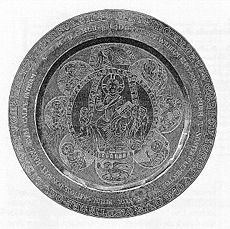John II, Margrave of Brandenburg-Stendal
| John II, Margrave of Brandenburg-Stendal | |
|---|---|

Paten depicting John II and his wife, Hedwig of Werle, from the Chorin Abbey, 1280/1290
|
|
| Noble family | House of Ascania |
| Father | John I, Margrave of Brandenburg |
| Mother | Sophie of Denmark |
| Born | 1237 |
| Died | 10 September 1281 |
John II, Margrave of Brandenburg-Stendal (1237 – 10 September 1281) was co-ruler of Brandenburg with his brother Otto "with the arrow" from 1266 until his death. He also used the title Lord of Krossen, after a town in the Neumark.
John II belonged to the Brandenburg line of the House of Ascania and was the eldest son of Margrave John I and his first wife, Sophie of Denmark (1217–1247), the daughter of King Valdemar II of Denmark and his second wife, Berengaria of Portugal. Since he was only co-ruler and appeared in the limelight less often than his brother, less is known about him than the other Ascanian Margraves of Brandenburg. On one occasion in 1269, he was consignatory of the Treaty of Arnswalde with Duke Mestwin II of Pomerelia. Nevertheless, he is one of only two of the co-rulers of this time (the other being Otto IV) to be given a statue on the Siegesallee in Berlin by Kaiser Wilhelm II.
Most of what is known about John II relates to Chorin Abbey. This was a Cistercian abbey that his father had founded in 1258 under the name Mariensee, where he intended the Margraves of Brandenburg-Stendel would be buried, considering that Lehnin Abbey, where the earlier margraves had been buried, was located in the part of the Margraviate held by the Brandenburg-Salzwedel line.
In 1273 the three brothers, Otto IV "with the arrow", John II and Conrad I (the father of Waldemar, the last great Margrave of Brandenburg from the House of Ascania) issued a joint declaration confirming the move of the Mariensee monastery to Chorin. Their three seals show the same picture of a standing armed Margrave with an eagle on his shield and the margraviate flag flying from his lance. They only differ in the inscription, which associate each seal with one of the brothers.
...
Wikipedia
